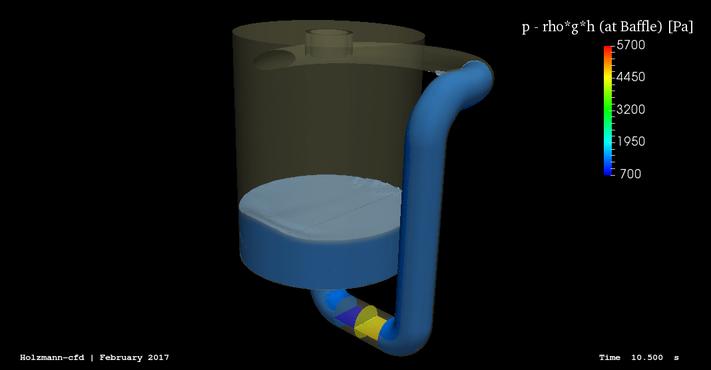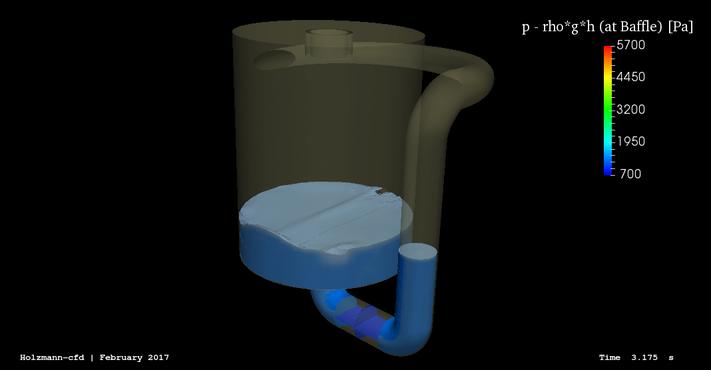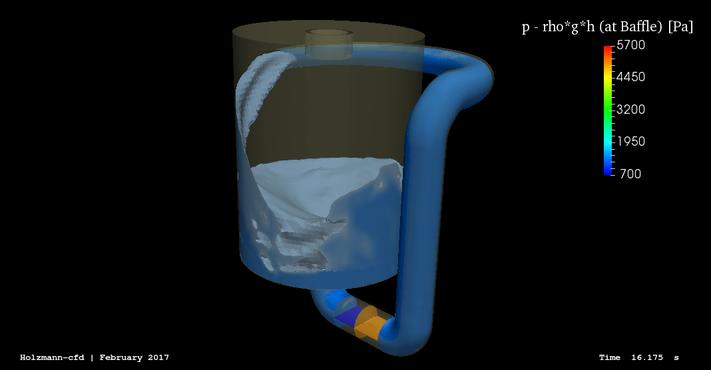Arbitrary Water Pumpe
interFoam, multiphase, cyclic fan/fixedJump boundary condition
Simplifications to the numerical continuum are used in numerical investigations almost in every scenario. In most cases, particular regions are not of primary interest. An example is given in the following training case, in which a water pump (which is just generating a pressure drop) is removed and replaced by a 1D cyclic boundary condition. The simplification leads to less numerical cells and, therefore, a reduction of computational costs.
OpenFOAM® offers a wide range of different boundary conditions
The generation of cyclic boundary patches can be used for periodic analysis as well as for particular applications such as modeling a fan or pump. Here, a pressure drop is applied between the cyclic patches. Based on the pressure momentum coupling, the fluid will accelerate based on the set-up. The case has the standard bash script, which explains the single steps needed to build the cyclic patches as well as the set-up of the appropriate boundary condition. The case runs in two different modes. After meshing, the filling stage starts for a defined time. In manner two, the boundary conditions are changed, and the pressure drop is applied, resulting in pumping the fluid up.



Published under the GNU General Public License 3
Over the last ten years, Tobias tried to publish a wide range of different materials related to OpenFOAM® and CFD. You know it much better than he does if the content is worth to be supported. If you want to thank Tobias for the work he did, feel free to tell the community your opinion about the work Tobias Holzmann is doing or you can email your thoughts directly to »
Support the work of Tobias Holzmann
The available OpenFOAM® training cases are tested and built for different OpenFOAM® versions (not distributions) on a Linux machine. During the tests, only the OpenFOAM Foundation version of OpenFOAM® was used. Furthermore, the following software packages are required for most of the training cases: Salome®, ParaView®, and for optimization tasks, one also needs the open-source software DAKOTA®. The OpenFOAM® cases might work with the ESI version of OpenFOAM® but it is not supported. For the OpenFOAM® extend project, the training cases will probably not work as the code diverged too much. Additionally, there is no support for Windows-based and MAC-based OpenFOAM® versions.
This offering is not approved or endorsed by OpenCFD Limited, producer and distributor of the OpenFOAM software via www.openfoam.com, and owner of the OPENFOAM® and OpenCFD® trade marks
Share the work on Your social network
Tobias would be grateful if you share his work on your social network in order to keep the OpenFOAM® community up to date. Furthermore, sharing the work will avoid that people investigate into topics, that are already prepared for your study such as the examples provided by Tobias Holzmann.
Release notes
| OpenFOAM® v8 | Since this version, the boundary condition »fixedJump« is used to create the pressure jump across the cyclic patches |
| OpenFOAM® v2112 |
Changes compared to OpenFOAM® v9:
|


